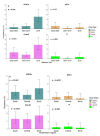Molecular Epidemiology and Trends in HIV-1 Transmitted Drug Resistance in Mozambique 1999-2018
- PMID: 36146798
- PMCID: PMC9505726
- DOI: 10.3390/v14091992
Molecular Epidemiology and Trends in HIV-1 Transmitted Drug Resistance in Mozambique 1999-2018
Abstract
HIV drug resistance (HIVDR) can become a public health concern, especially in low- and middle-income countries where genotypic testing for people initiating antiretroviral therapy (ART) is not available. For first-line regimens to remain effective, levels of transmitted drug resistance (TDR) need to be monitored over time. To determine the temporal trends of TDR in Mozambique, a search for studies in PubMed and sequences in GenBank was performed. Only studies covering the pol region that described HIVDR and genetic diversity from treatment naïve patients were included. A dataset from seven published studies and one novel unpublished study conducted between 1999 and 2018 were included. The Calibrated Population Resistance tool (CPR) and REGA HIV-1 Subtyping Tool version 3 for sequences pooled by sampling year were used to determine resistance mutations and subtypes, respectively. The prevalence of HIVDR amongst treatment-naïve individuals increased over time, reaching 14.4% in 2018. The increase was most prominent for non-nucleoside reverse transcriptase inhibitors (NNRTIs), reaching 12.7% in 2018. Subtype C was predominant in all regions, but a higher genetic variability (19% non-subtype C) was observed in the north region of Mozambique. These findings confirm a higher diversity of HIV in the north of the country and an increased prevalence of NNRTI resistance among treatment naïve individuals over time.
Keywords: HIV; Mozambique; drug; genetic diversity; molecular epidemiology; mutations; resistance; temporal trend; transmitted; treatment naïve.
Conflict of interest statement
The authors declare no conflict of interest.
Figures




References
-
- Global HIV & AIDS Statistics—Fact Sheet|UNAIDS. [(accessed on 12 April 2022)]. Available online: https://www.unaids.org/en/resources/fact-sheet#:~:text=People%20living%2....
-
- Hoffmann C.J., Mills L.A., Gallant J.E. Future of HIV/AIDS Care in Low- and Middle-Income Countries. In: Celentano D.D., Beyrer C., editors. Public Health Aspects of HIV/AIDS in Low and Middle Income Countries. Springer; New York, NY, USA: 2009. pp. 41–69.
Publication types
MeSH terms
Substances
Grants and funding
LinkOut - more resources
Full Text Sources
Medical

